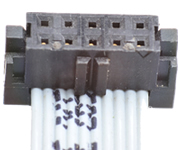Föhrenbach Expert Insights.
IDC
The IDC Concept
IDC (Insulation Displacement Contact) was originally intended for quick, inexpensive, and reliable interconnections in low voltage applications. It evolved from a single solid wire solution into a technology that can also be used for stranded wires. Cables can be single or multiple, as for example in the case of flat- or ribbon cables. There are two types of contacts: parallel-shaped blades and contacts equipped with protrusions. When the connector is applied, the blades or protrusions cut through the insulation of the conductor and make contact with the wire, thus creating a theoretically gas-tight connection. The big advantage of IDC is that it eliminates the need for cable stripping.

Flat- or Ribbon cables
Ribbon cables consist of multiple parallel wires and are specified by their number of conductors (Ways) and the spacing or distance between the conductors (Pitch). The pitch can be metric, like 1 mm or defined in inches. Typical examples of imperial ribbon cable pitches are 0.05 inch or 1.27 mm and 0.025-inch or 0.64 mm. Föhrenbach Application Tooling solutions for IDC flat cable can be adapted for every possible pitch and are perfect for cables with high numbers of conductors, thanks to our modular concept with easily interchangeable connector adapters.

Föhrenbach Application Tooling N.V.
Your Trusted Link To Interconnection Solutions.
If you have questions about our products, pricing, security, implementation or anything else, please contact us today. We speak English, French, German and Dutch.
“Helping companies solve connectivity challenges since 1984.”